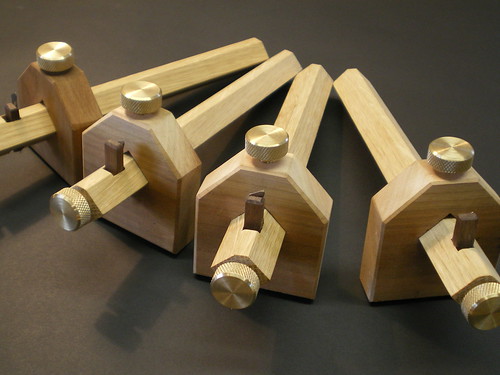ivan":rvvur182 said:
Lee Valley's jig as supplied probably holds a larger variety of blades referenced from the correct surface, than any other, but it's not perfect. It might be if it gripped the sides of tapered chisels like the Eclipse style as modified by David Charlesworth.
Hi Ivan,
Please, please don't take this personally - it took me ages to get my head around - but once I did it was like the clouds parted and I could hear the angels singing.
The Veritas sandwiches the blade with the bevelled (non-referance) face on top of the big machined block and then has a lighter, broad bar screwed down onto the back - the face that we measure the bevel angle relative to.
If they had machined the underside of the block and put the attachment gubbins down there with a narrow, v shaped or pivoted bar, then it
would be referencing off the correct surface. The bar would make a single line of contact on the bevelled side and the larger contact area between the block / back of the blade would define the referance plane; which is what happens on the Kell 3 - the wedge is free to pivot about its line of contact with the 'axle'. This is what DC was trying to correct with his modification of adding plates to the top of the eclipse, undoubtedly a significant move in the right direction, but I wouldn't recognise it as the best solution so start from if I were designing a guide from scratch.
Another thing that I think they could have done better is the twin thumbscrews that hold the clamping bar in place. This arrangement takes time to tighten and release, the screws must be tightened evenly in order to avoid gripping one side of the blade more than the other and it applies the force unevenly across the blade (lots on the sides less in the middle). From a business/marketing perspective it was absolutely the right thing to do, shiny brass knobs will sell more guides than unappealing wedges, especially if you get to make the wedges yourself. However from a purely functional point of view, the ancient technology of the wedge is superior both mechanically and practically.
ivan":rvvur182 said:
Surely rollers on the grinding medium are only a problem with waterstones, where the large amount of slurry on 800/1200 grit stones makes it likely you'll get it in the wheel's bearings? No problem on diamond or 8000 grit waterstone.
Broad rollers on the stone are not a great problem for most people, if the roller is going to wear the stone it will do so evenly and as long as you wash and dry it carefully (especially with well specified kit like the Veritas) it's going to give years of service before the bearing surfaces suffer to the point where the roller needs replacing. If someone already has the Veritas Mk2 and they get on well with it I wouldn't recommend changing. I'll happily explain to them why I believe the Kell 3 is better, but the Veritas is still a good piece of kit and for many people it produces the results they are after.
The reason that Richard installed the wheels either side side of the area that the blade travels along had nothing to do with keeping them clean or avoiding wear, althought these are fringe benefits. It was done to make the guide stable, like a tricycle, so the guide forces the blade to sit square on to the sharpening media, resulting in a square edge.
Taking the opposite extreme i.e. a single central wheel and a blade that is wider than the wheel, the tricycle is reversed, so the blade is telling the guide where to go rather than the other way around. Yes, you can lean on the edges of the guide to create a camber, and you can shim under the wheels of the Kell as Rob describes in his original post to achieve a camber. The difference is that leaning on the centre of an eclipse type guide doesn't produce square, it produces more of whatever angle you had before.
The broad roller of the Veritas will also dictate squareness to the blade (and you can shim under the sides to do cambers rather than buying a barrel shaped roller for it - but don't tell Rob Lee I told you so.)
Squareness isn't essential for all types of blade, bench planes have lateral adjusters for example, but it
is necessary for some and it
does give you a known starting point, which is absolutely critical to achieving repeatability and control.
There are a wide range of honing guides on the market, very few of which are completely useless but many seem to have been designed specifically for one or two things that you might want to sharpen rather than all of them. Richard on the other hand has given a great deal of thought to the fundamental principles and produced a dead simple but very clever and well engineered piece of kit. It's a bit like a survival knife in that it still requres the application of some nowse and the materials you have at hand, but with those you can make it do an enormous variety of tasks with an astonishing degree of accuracy and control.

































